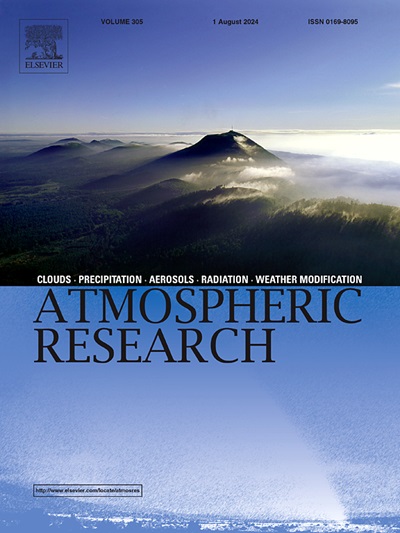极端闪强降水超级单体与江淮地区其他强超级单体有何不同?
IF 4.5
2区 地球科学
Q1 METEOROLOGY & ATMOSPHERIC SCIENCES
引用次数: 0
摘要
利用雷达观测资料和ERA5再分析资料,揭示了2020-2021年中国江苏省与极端闪强降水(FHR,小时降雨强度≥50 mm)相关的超级单体的中气旋特征,并揭示了它们与冰雹、大风、龙卷风等对流危害相关的其他强超级单体的差异。结果表明:FHR超级单体多出现在7月和8月,季节上晚于该地区的冰雹超级单体和大风超级单体;暖季期间,由于FHR超级单体大多出现在西太平洋副热带高压北缘,因此在西风气流的引导下,超级单体一般向东移动。一半的FHR超级单体中气旋只维持约2-3次雷达体积扫描(12-18分钟)。大多数极端FHR超级单体都嵌入在中尺度对流系统中,并在更有利的位置触发,那里有更丰富的水汽汇聚和更强的低层垂直风切变产生。相比之下,发展中的极端FHR超级单体通常需要更丰富的水分,但不像冰雹或大风超级单体那样需要更高的对流有效势能或更强的垂直风切变。在中气旋特征上,龙卷风超级单体的旋转强度最强,其次是大风和冰雹超级单体,FHR超级单体的旋转强度最弱。冰雹超级单体的风暴直径最大、中气旋最深、最强旋转高度最高,其次是大风超级单体、FHR超级单体和龙卷风超级单体。这些差异可能与超级单体引起的各种强对流现象的形成机制不同有关:冰雹生长在较低的环境温度下,因此对应于超级单体的最高垂直延伸;长江-淮河地区大部分对流风暴与中高层干空气夹带有关,并引发强烈的蒸发效应;龙卷风超级单体的定义意味着最小直径和最强旋转必须接近地面。相比之下,该地区的大多数FHR事件与暖雨过程有关。本文章由计算机程序翻译,如有差异,请以英文原文为准。
How are supercells with extreme flash heavy rainfall different from other severe supercells in the Yangtze-Huai River Region?
Using radar observation data together with ERA5 reanalysis data, this study exposes the mesocyclone characteristics of supercells associated with extreme flash heavy rainfall (FHR, hourly rainfall intensity ≥50 mm) in Jiangsu Province of China during 2020–2021, and reveals their differences from other severe supercells associated with convective hazards such as hail, gales and tornadoes. The results show that most FHR supercells occur in July and August, seasonally later than hail supercells or gale supercells in this region. During the warm season, FHR supercells generally move eastward led by westerly flow since most of them appear along the north edge of the western Pacific subtropical high. Half of FHR supercell mesocyclones sustain only about 2–3 radar volume scans (12–18 min). Most extreme FHR supercells are embedded in mesoscale convective systems and are triggered at more favorable locations where more abundant moisture converges and stronger low-level vertical wind shear is produced. In comparison, the developing extreme FHR supercell generally needs more abundant moisture but not as much higher convective available potential energy or stronger vertical wind shear as hail or gale supercells. In terms of mesocyclone characteristics, tornadic supercells exhibit the strongest rotation intensity, followed by gale and hail supercells, and FHR supercells possess the weakest rotation intensity. Hail supercells have the largest storm diameter, deepest mesocyclone, and highest elevation of strongest rotation, followed by gale supercells, FHR supercells and tornadic supercells. These differences are possibly related to the distinct formation mechanisms of the various severe convective phenomena induced by supercell: hail grows in lower ambient temperature and therefore corresponds to the highest vertical extension of supercell; the majority of convective windstorms in the Yangtze-Huai River region is associated with mid-upper-level dry air entraining into the storm and triggering a strong evaporative effect; and the definition of a tornadic supercell implies that the least diameter and the strongest rotation must approach ground. In contrast, most FHR events in this region are linked to warm-rain processes.
求助全文
通过发布文献求助,成功后即可免费获取论文全文。
去求助
来源期刊

Atmospheric Research
地学-气象与大气科学
CiteScore
9.40
自引率
10.90%
发文量
460
审稿时长
47 days
期刊介绍:
The journal publishes scientific papers (research papers, review articles, letters and notes) dealing with the part of the atmosphere where meteorological events occur. Attention is given to all processes extending from the earth surface to the tropopause, but special emphasis continues to be devoted to the physics of clouds, mesoscale meteorology and air pollution, i.e. atmospheric aerosols; microphysical processes; cloud dynamics and thermodynamics; numerical simulation, climatology, climate change and weather modification.
 求助内容:
求助内容: 应助结果提醒方式:
应助结果提醒方式:


